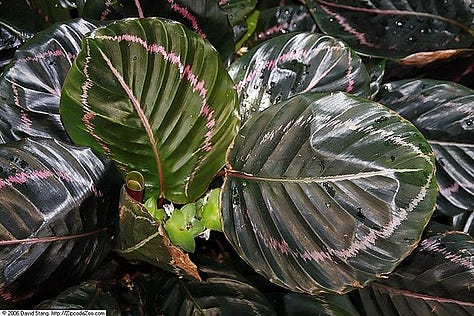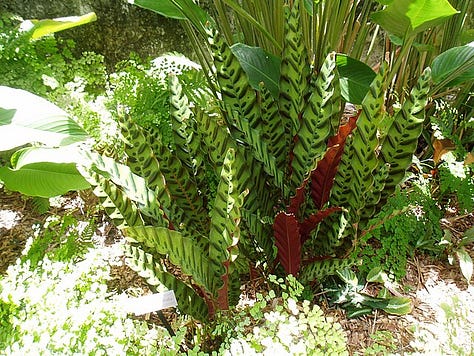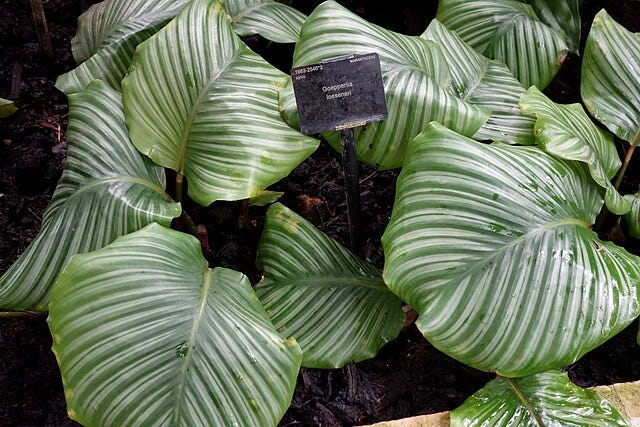We’re tackling a group of South American plants today at the lab because they all share one very interesting, and puzzling behavior. Goeppertias and Calatheas both belong to the Marantaceae family, also known as the prayer plant family. Popular as houseplants not only for their striking foliage, these plants do a complex crepuscular dance that is as impressive as it is mysterious.
Plants now called Goeppertia used to be called Calathea, but it turns out the two groups have different flower structures and so must be classified as different genera. That said, none of them are likely to flower indoors, so the distinction isn’t going to matter much to houseplant enthusiasts. To visually orient you, here are a few different types of Goeppertia and Calathea.





As you can see, they’re stunning. To me their dark patterns always seem particularly gothic. So what else makes them interesting? Their dance. Every morning, as the sun rises, the leaf stems will bend, lowering the leaf to a nearly horizontal position, then at night, as the sun sets, the leaves close up, standing vertically and clustering together.
The botanical term for this behavior is nyctinasty, combining nyct meaning night and nastic referring to plant movement. So yeah, night moves. Cue the vampire disco.
How plants do this is something scientists do understand. A structure at the base of each leaf called a pulvinus facilitates movement by regulating water pressure flowing through it.
But WHY they do it is another matter altogether. There are lots of theories. Here are a few from a National Library of Medicine article I found:
(i) improves the temperature relations of plants; (ii) helps remove surface water from foliage; (iii) prevents the disruption of photoperiodism by moonlight; and (iv) directly discourages insect herbivory.
I’ll briefly explain the above. Temperature relations means that the plant moves to reduce either heat loss or the chance of freezing, depending on whose theory they’re referring to. Goeppertia and Calathea both live in wet tropical areas where water can easily accumulate on leaves, so the second theory is that the leaves stand up vertically at night to allow this water to run off into the soil around it. Photoperiodism is the response of plants to seasonal changes in light, presumably the theory is that the plant is folding up at night so that moonlight doesn’t throw off its seasonal growth. And finally, folding up at night could prevent nocturnal insects from accessing the plant.
But my favorite theory is that the plants move in order to make it easier for nocturnal predators to catch herbivores. Essentially it’s as if the plant is folding up its leaves at night to give predators more room to chase prey and to better allow scents to flow along the ground. Obviously this is beneficial for the plant as it is not only not getting eaten at night, but fewer of its devourers will remain in the morning. There isn’t any consensus as to this theory and its entirely possible we’ll never know, but I love the idea of these dark, gothic looking plants making some kind of infernal pact with the carnivores around them.
Very Machiavellian.
So that’s it! This month’s plant will serve as inspiration for the paid posts in my 100% Plant-Based Horror sections. Here’s the breakdown, in case you’re new and/or curious.
First week of the month - The Lab (that’s this post!) - Free for everyone
Second week of the month - The Witch Lab (a short, spooky piece from a plant witch’s journal detailing one of her experiences helping (I use the term loosely) a client with the featured plant of the month) - Paid subscribers only, here’s a freebie you can read to check it out!
Third week of the month - The Spell Book (an entry from The Witch’s spell book detailing how she uses this plant for her dark magic including spells, chants, recipes, instructions, and more). Paid subscribers only, here’s a freebie you can read to check it out!
Fourth week of the month - 100% Plant-Based Horror story featuring the month’s plant. These are longer stories that include everything from ghosts, to parasites, aliens, experimental supplements, and more! - Paid subscribers only, here’s a freebie you can use to check it out!



Interesting behavior.
If these plants are tropical, the idea that this is a response to either photoperiodism or freezing is nonsense. It does make sense that it might allow water to run off the leaves, thus potentially reducing fungal infections. The "make room for carnivores!" explanation seems a little far fetched, but I agree it's a fun idea!
The fact is, as Gould pointed out in his famous "Spandrels of San Marcos" paper, there may be absolutely no adaptive significance to this at all!😁
wow...nyctinasty. I love that.